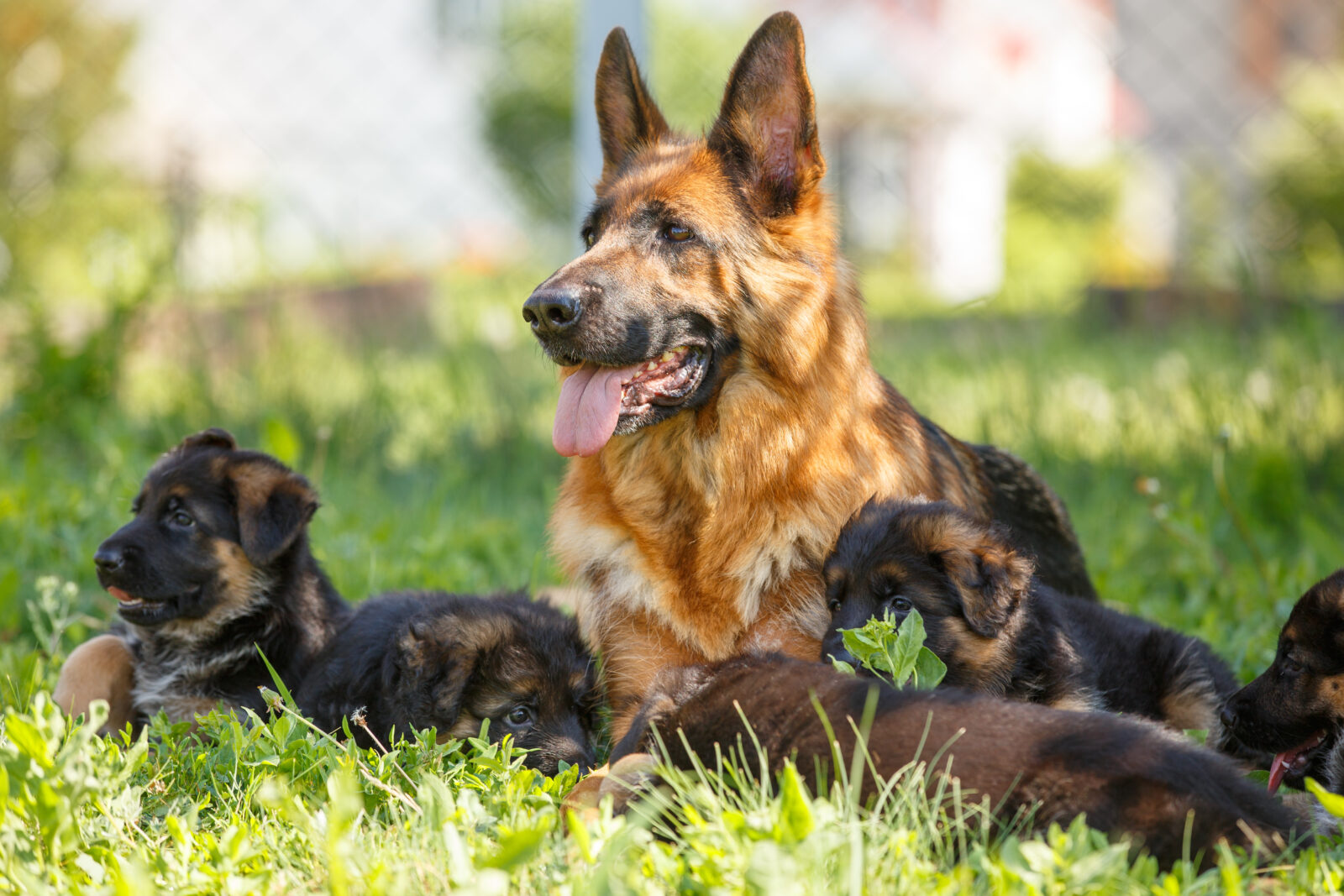
Considering starting a dog breeding business? Breeding dogs can be rewarding, but knowing where to begin is challenging. From selecting the right breed to choosing appropriate whelping features for your kennel, there are many factors to consider. To assist you, we’ve created a comprehensive guide outlining the steps and considerations for how to start a dog breeding business. Let’s dive in:
Table of Contents
1. Research Breeding

One of the reasons starting a dog breeding business is so unique compared to other dog businesses is that it requires knowledge of breeding. You’ll need to be knowledgeable about dog genetics, breeding practices, whelping, and puppy care.
2. Selecting & Breeding The Right Dogs

The success of your business starts with choosing the right breeds and breeding partners.
- Select Your Breed: Choose a breed you’re passionate about and knowledgeable in, while also considering market demand. Focus on breed-specific health concerns, temperament, and care needs.
- Choose Complementary Mating Pairs: Select a sire (male) and dam (female) registered with a reputable club, such as AKC, and ensure their genetics complement each other. Focus on improving traits like coat, health, or temperament while addressing weaknesses. Seek advice from experienced breeders and conduct thorough research.
- Develop a Stud Contract: Once you’ve found the ideal partner, it’s important to work out a contract with the stud dog owner before breeding. The contract will include obligations and circumstances for breeding which ensures both parties keep up their end of the bargain.
- Breed to Improve: Strive to enhance breed standards by selecting dogs that complement each other’s strengths and minimize weaknesses. Avoid overbreeding to maintain the health and welfare of your dogs.
- Find Reputable Breeders: Source dogs with excellent pedigrees, health clearances, and good temperaments. Ensure they undergo genetic screenings and have all necessary vaccinations.
3. Legal & Financial Setup

The first step in launching your business is to ensure you meet all legal and financial requirements.
- Register Your Business: Choose a name and register it according to local regulations.
- Obtain Permits and Licenses: Check your municipality’s requirements for breeding licenses or special permits.
- Secure Insurance: Protect your business with liability insurance to cover unexpected issues.
- Set Up Finances: Create a tax-compliant system for tracking expenses and revenue.
4. Set Up Your Kennel

This step requires a lot of careful preparation to ensure that you have the best setup possible for your business. Below you’ll find a more comprehensive guide on choosing the right dog kennel for breeding.
5. Develop Breeding & Care Protocols

Establish ethical and effective protocols to maintain high standards in your breeding operation.
- Plan for Health: Work with a trusted veterinarian for pre-breeding health checks, regular checkups, vaccinations, and emergency care.
- Prevent Overbreeding: Schedule appropriate gaps between litters to allow dogs time to recover.
- Record Keeping: Maintain detailed records of breeding cycles, health tests, litters, and sales to monitor your progress.
- Provide Quality Nutrition: Feed your dogs high-quality food tailored to their specific needs.
6. Marketing Your Business

Build your brand and attract customers with effective marketing strategies.
- Create a Website: Showcase your kennels, breeding philosophy, and available puppies. Include testimonials and FAQs to build trust with potential buyers.
- Use Social Media: Share updates, photos, and videos of your puppies to engage with potential customers.
- Attend Events: Promote your business by attending dog shows, breeder conferences, and training events.
- List on Directories: Register your kennel on reputable breeder directories to increase visibility.
7. Ensure Your Puppies Are Being Sold Ethically

Ensure a responsible and ethical approach when selling puppies.
- Screen Buyers: Check that potential owners are ready and capable of caring for a dog.
- Draft a Contract: Include buyer responsibilities, health guarantees, and return policies in a written agreement.
- Offer Ongoing Support: Stay in touch with buyers and provide advice on puppy care.
8. Track Your Progress and Develop A Plan To Improve

Continuously evaluate your business to identify opportunities for growth and improvement.
- Monitor breeding outcomes, customer satisfaction, and financial performance.
- Adjust protocols and marketing strategies based on your findings to enhance success.
How To Start A Dog Kennel For Breeding:
Breeders should start by designing and developing a kennel tailored to the needs of the dog they are producing, from puppy to adult. A dog owner or professional breeder should also consider how the kennel will affect their dogs’ health, behavior, and happiness. Illness, behavioral issues, harsh circumstances, and costly corrections can all result from poorly built kennels.
4 Health & Safety Factors to Consider
1. Ventilation Inside The Dog Kennel
Both inside and outside the cages, your kennel should have enough airflow. When there are many dogs in a small enclosed space, both odors and airborne microparticles can accumulate. Without ventilation, not only will there be unpleasant scents, but it will also be easier for infections to spread.
2. Cleanliness Of The Dog Kennel
The smallest feature that is included in your dog kennel for breeding can sometimes save you a lot of time and mess. Choosing a custom dog kennel with simple slide-out trays, raised flooring, and drain trenches makes cleaning a breeze. It also keeps urine and feces from accumulating in the kennel, leading to messes and illnesses in the puppies.


3. Size of Your Dog Kennel
Consider the standard guideline when sizing your kennels, not too big, nor too small. Your dogs may become more difficult to train if they have too much room to roam inside their kennel. If the kennel is too small, it becomes uncomfortable, and inhuman, and can lead to behavioral problems.
4. The Material Used To Build The Dog Kennel
Choosing kennels constructed of long-lasting materials like stainless steel can help improve your kennel’s safety, lifespan, and cleanliness. Plastic cages may save money in the short term, but they are easily broken and scratched, causing harm to your puppies. In addition, because plastic absorbs liquids, urine, feces, and spills can settle into the material, resulting in ugly appearances, bad scents, and health risks.
Find A Dog Kennel With Whelping Options

The whelping process is a critical stage in any dog breeding business, and having the right kennel setup can make all the difference. A kennel with built-in whelping features ensures a smoother birthing process for the mother and supports the health and growth of her puppies. Here’s what to look for:
- Whelping Bed: A whelping bed or box keeps puppies safe and close to the heat source, which is vital in their early weeks since they cannot regulate their own temperature. This setup helps prevent chilling and ensures the puppies remain warm and secure.
- Whelping Heaters: An adjustable heat source is essential for maintaining the correct temperature in the kennel. For the first few days, the temperature should be kept between 85–90°F. After the first week or two, it can be gradually lowered to around 72°F to accommodate the puppies’ growing ability to regulate their body temperature.
Investing in a kennel with these features not only simplifies the whelping process but also sets the foundation for healthy, thriving puppies.
Looking for A Kennel Equipped With All The Essential Features You Need for Your Business?
At The Dog Kennel Collection, we specialize in designing custom commercial dog kennels tailored to the needs of breeders and other industries. We’re happy to collaborate with you to equip your kennel with essential whelping features through our trusted supplier, Backyard Pet Supplies.
Want to see how we’ve helped other commercial dog businesses like yours? Hear from our customers, like Chantel, who called it the best decision she made for her dog breeding operation. Let us help you create the ideal setup for your breeding success!

Locate The Nearest Dealer To You
Find a dog kennel dealer near you for you to start breeding by just clicking on the button below and putting in your address information. We can bring your dog kennel to your door with our trusted dealers all over the US.

Contact Us
If you need any further assistance or have any questions regarding our commercial dog kennels or anything else on our website, please contact us, and we will be sure to help you find the dream dog kennel that you have been looking for.

Request A Catalog
We hope you enjoyed reading about how to start a dog kennel for breeding. Our commercial dog kennels are very popular buildings for dog trainers, breeders, boarders, groomers, and veterinarians. You can start your dog kennel for breeding by requesting a catalog and choosing the kennel that will fit your needs. It starts with a click, then you will fill out the form with some contact information, and then we will send you a catalog where you can see all of our dog kennels.



